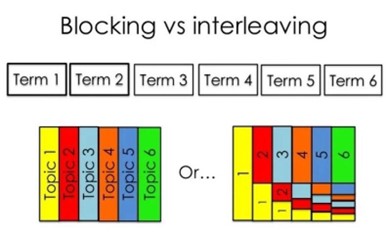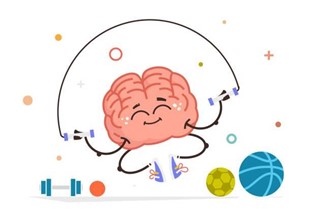C. Example Neuromyth in Higher Education
Although many theoretical descriptions of individual neuromyths exist that delineate certain individual arguments or counterarguments, only some of them have been systematically described with respect to their kernel of truth, individual erroneous conclusions and appropriate counterarguments (Grospietsch and Mayer, 2018; 2019; 2021a; 2021b; Grospietsch 2019). We selected those that University educators could possibly meet in Higher Education.

Description of the Neuromyth
Torrijos-Muelas M., González-Víllora S., Bodoque-Osma, A. (2021) mention that closely related to education, we can find the neuromyth of the visual, auditory, and kinaesthetic (VAK) learning styles. There are three mythical conclusions about the learning styles. The first erroneous conclusion that can be drawn from this kernel of truth is that there are auditory, visual, haptic and intellectual learning styles, as Vester (1975). The next erroneous conclusion drawn is that people learn better when they obtain information in accordance with their preferred learning style. Finally, the third erroneous yet widely disseminated conclusion is that teachers must diagnose their students’ learning styles and take them into account in instruction. According to Grospietsch and Mayer (2021b), the kernel of truth behind this neuromyth is that people differ in the mode in which they prefer to receive information (visually or verbally; e.g., Höffler et al., 2017).
The effects of the Neuromyth on Education
As Torrijos-Muelas M., González-Víllora S., Bodoque-Osma, A. (2021) mention, even there is lack of evidence the neuromyth of the learning styles, it is one of the most deeply rooted belief among teachers, educators, and students. (Rodrigues Rato et al., 2013, Deligiannidi and Howard-Jones, 2015; Papadatou-Pastou et al., 2017, 2018; Varas-Genestier and Ferreira, 2017; Zhang et al., 2019). Educators report having been taught about the existence of learning styles during training courses organized by their schools or the educational authorities of their governments (Lethaby and Harries, 2016; Kim and Sankey, 2017; McMahon et al., 2019).
Torrijos-Muelas M., González-Víllora S., Bodoque-Osma, A. (2021) also add that the educators in Higher Education use this neuromyth in their practice, and what is even more dramatic is that when a professor indicated there was no empirical evidence for VAK learning (Rohrer and Pashler, 2012; Grospietsch and Mayer, 2018), 46% claimed they would find benefits from using it in class (Newton and Miah, 2017). However, previous reports confirm that there is no relation between a student’s self-evaluation about their preferred learning style and the style the teacher attributes to them (Papadatou-Pastou et al., 2018), with <50% of agreement between student self-report and a learning style questionnaire (Krätzig and Arbuthnott, 2006). The fact is that we do not learn using just one sense, and VAK learning does not explain how the brain learns (Geake, 2008; Dekker et al., 2012). Using this as a theory or a valid explanation is just a teaching heuristic based on observations (Schwartz, 2015), an over-simplification (Purdy and Morrison, 2009), and a more than questionable practice (Bailey et al., 2018). In line with previous studies, this neuromyth still appears in training, education degrees, universities, or books (Gleichgerrcht et al., 2015; Lethaby and Harries, 2016; Kim and Sankey, 2017; Grospietsch and Mayer, 2018; McMahon et al., 2019; Tan and Amiel, 2019), sometimes as a general educational trend (Papadatou-Pastou et al., 2018). Moreover, some educators insist they intend to continue working under this perspective in their classrooms, even knowing that it is a neuromyth (Newton and Miah, 2017; Tan and Amiel, 2019).
How to ‘spot’ Neuromyth –The Scientific Perspective
To spot a neuromyth you need to look for scientific evidence. Even it is true that there may be preferences and, perhaps more importantly, that presenting information in multiple sensory modes can support learning, Vester’s model of learning styles is not even logically consistent, because it compares three sensory channels to an ‘intellectual’ learning style (Looß, 2001). Tests of learning styles are unreliable from a measurement perspective and are unable to accurately categorize heterogenous groups of learners (Coffield et al., 2004; Pashler et al., 2008). Moreover, there is no empirical evidence confirming the effectiveness of considering students’ learning styles in instruction (Willingham et al., 2015). Regardless of the mode in which it is presented, information must be meaningfully processed, repeated and elaborated. In addition Howard-Jones, P. A. (2014) mention that if a person feels that they learn best by writing the content down in their own words, this is not because they then see what they have written down, but rather because writing something down in one’s own words serves as an elaboration strategy (Grospietsch and Mayer, 2021b).
Additional Resources
- Learning styles-A complete myth -Video Animation (14.26min.)
- Newton, P. M., & Miah, M. (2017). Evidence-Based Higher Education – Is the Learning Styles ‘Myth’ Important? Frontiers in Psychology, 8, 444.
- Furey, W. (2020). THE STUBBORN MYTH OF “LEARNING STYLES”: State teacher-license prep materials peddle a debunked theory. Education Next, 20, 8+
- Learning Styles (Greek content)
- https://physiart.com/2018/07/12/02-learning-myth-learning-styles/
- 5 learning myths-debunked
- https://www.educationnext.org/stubborn-myth-learning-styles-state-teacher-license-prep-materials-debunked-theory/
- Παναγιωτακόπουλος (στα ελληνικά) #02 – Εκπαιδευτικός μύθος ή αλήθεια – Τα μαθησιακά στυλ (2018)

Description of the Neuromyth and Mythical Assumptions
A neuromyth that has to date largely been addressed in the context of cognitive psychology and ‘desirable difficulties’ (e.g., Bjork and Bjork, 2011; Lipowsky et al., 2015) is the notion that blocked learning is better than interleaved (Grospietsch and Mayer, 2019). According to Grospietsch (2019), the kernel of truth underlying this neuromyth is that instructional designs in which the learning content is systematically structured facilitate positive learning effects among students (e.g., Hattie, 2009).
Blocked learning is a commonly used learning sequencing method in academic settings. It is the process of concentrating on a specific skill or lesson until it is mastered. After that material is learned, students are taught the next skill.
Interleaved learning happens when we study two or more related concepts or skills simultaneously, instead of focusing exclusively on one concept or skill at a time. It can be helpful to alternate between them. For example, if we are learning topic A and topic B, rather than practice only A on one day and only B on the next, we can practice both on each day by incorporating a mixture of the two topics or by switching back and forth between them.
The effects of the Neuromyth on Education-Mythical Conclusions
From this, it is erroneously concluded that students become overwhelmed when instructional topics are not taught one after another in a structured, sequential way. Hence, educators who believe in this neuromyth may design learning activities accordingly. A related assumption is that students’ knowledge acquisition is more sustainable when the learning process is simplified, and quick and easy success during learning improves students’ long-term retention of the learning content. Thus, it is recommended that teachers follow the structure of school textbooks and teach topics one after another chronologically.
How to ‘spot’ Learning Styles Neuromyth-The Scientific Perspective
From a scientifically accurate perspective, however, students who engage in interleaved learning (mixed, juxtaposed learning of different topics) have better scores on long-term performance tests (after several weeks or months have passed) and develop fewer misconceptions than students who sequentially learn content on one topic after another (e.g., Rohrer and Taylor, 2007; Ziegler and Stern, 2014). Research findings on desirable difficulties demonstrate the positive effects on students’ knowledge acquisition of deliberately making learning processes more difficult (e.g., Bjork and Bjork, 2011; Dunlosky et al., 2013; Lipowsky et al., 2015) and that interleaved learning is superior to blocked learning in the long term (e.g., Mayfield and Chase, 2002). Cognitively demanding activities result in slow, not immediately visible learning successes, yet improve long-term retention of what has been learned (e.g., Carvalho and Goldstone, 2014; Bjork and Kroll, 2015).

Introductory videos
Description of the Neuromyth-Mythical Assumptions
The neuromyth is that logic is located in the left hemisphere, creativity in the right (e.g., Hines, 1991). Several theoretical descriptions of the neuromyth regarding learning differences due to hemispheric use also exist (Organisation for Economic Co-operation and Development [OECD], 2002; Becker, 2006; Geake, 2008; Alferink and Farmer-Dougan, 2010; Lilienfeld et al., 2010; Lindell and Kidd, 2011; Adey and Dillon, 2012; Jarrett, 2014; Tokuhama-Espinosa, 2018). Based on this kernel of truth, it is erroneously concluded that the two brain hemispheres have different strengths and weaknesses. According to Grospietsch and Mayer (2019), the cerebrum contains two hemispheres that are not completely identical from an anatomical or functional perspective (hemispheric asymmetry; e.g., Jäncke, 2013; Ocklenburg et al., 2014).
The effects of the Neuromyth on Education-Mythical Conclusions
It is assumed that every learner has a dominant hemisphere that they rely upon more strongly than the other, and that student (cognitive) characteristics are rooted in this ‘hemispheric dominance’ – misinterpreted as the strength of the two hemispheres. For example, analogously to the neuromyth that logic is located in the left hemisphere, creativity in the right (see below), it is allegedly the case that ‘left brain dominant’ learners are more talented in mathematics, while ‘right brain dominant’ learners are better able to complete creative tasks. Ultimately, the erroneous conclusion is drawn that learners cannot complete tasks that misalign with their hemispheric dominance or can do so only with great difficulty; thus, educators need to take into account whether learners are left-brained or right-brained in their instruction. Torrijos-Muelas M., González-Víllora S., Bodoque-Osma, A. (2021) mention that educators who believe in this Neuromyth, with 41.7% of references among the studies, have the idea that each hemisphere works autonomously and has a different function. Hence, students’ left hemisphere is responsible for intellectual, rational, verbal and analytical thinking, while the right hemisphere is responsible for creative, intuitive and non-verbal thought processes. Accordingly they can organize the learning activities.
How to ‘spot’ this Neuromyth –The Scientific Perspective
From a scientifically accurate perspective, however, the two hemispheres are linked to one another via the corpus collosum (Bloom and Hynd, 2005). They work together on all processing tasks (Singh and O’Boyle, 2004), as can be illustrated with the example of language: The left hemisphere is predominant in many but not all verbal processes. A few components of language are processed in the right hemisphere, including intonation and reading between the lines (Lai et al., 2015). Thus, the process is not completely lateralized (Nielsen et al., 2013). Moreover, it is learners themselves rather than brain hemispheres that possess different strengths and weaknesses rooted in their intelligence, use of learning strategies, interest, motivation, attention, etc. (Gruber, 2018). Hemispheric dominance merely means that one of the two hemispheres is more strongly involved in a specific cognitive process than the other. Functions are lateralized only to a certain extent. Generally speaking, information is stored throughout the entire architecture of a given neural network and thus in memory traces (engrams) throughout the brain. As long as the corpus collosum, the band of nerves linking the two hemispheres, remains intact, a constant exchange of information between the two hemispheres takes place, regardless of the type of activity being conducted (Bear et al., 2016).

Mythical Assumptions
A further neuromyth related to the relationship between the brain hemispheres concerns the effectiveness of Brain Gym (Becker, 2006; Hyatt, 2007; Stephenson, 2009; Howard-Jones, 2010; Adey and Dillon, 2012; Tokuhama-Espinosa, 2018). According to Grospietsch and Mayer (2021a), the kernel of truth underlying this neuromyth is that a crossed neural pathway links the left hemisphere of the brain to the right side of the body and vice versa (e.g., De Lussanet and Osse, 2012; Kinsbourne, 2013).
Mythical Conclusions
Based on this kernel of truth, it is erroneously concluded that motor problems during cross-body coordination exercises result from a lack of coordination between the two hemispheres. Learning difficulties are also said to result from a lack of cooperation between the two hemispheres. It is further erroneously concluded that cooperation between the two hemispheres can be improved by increasing the number of synaptic connections between them and that cross-body coordination exercises can improve one’s mental abilities. Ultimately, it is claimed that ‘Brain Gym’ programs available for sale can prevent learning difficulties, improve students’ learning or creativity, and even raise their intelligence.
The Scientific Perspective
From a scientifically accurate perspective, however, the two brain hemispheres are constantly exchanging information in coordination with one another as long as the corpus collosum, the band of nerves linking the two hemispheres, remains intact (Blais et al., 2018). Learning difficulties are instead attributable to differences in working memory capacity or processing speed (Willcutt et al., 2013). They can also be caused by a lack of attention, unfavorable motivational conditions, or deficits in the use of learning strategies (Creß and Friedrich, 2000; Grube and Ricken, 2016). We cannot consciously influence where synapses arise, and their formation is not a unique occurrence. New synaptic links form during each and every cognitive process (Zheng et al., 2013). While coordination exercises can improve students’ physical fitness levels and motor skills, they do not improve their cognitive performance (Cancela et al., 2015). Any subjectively or objectively perceived cognitive improvements result instead from the break from learning/improved circulation that accompanies such exercises (Budde et al., 2008).

Reading in advance: Common myths compromise good sleep
Description of the Neuromyth and Mythical Assumptions
The neuromyth on learning while you sleep is theoretically described much more rarely compared to the aforementioned neuromyths (Centre for Educational Research and Innovation [CERI], and Organisation for Economic Co-operation and Development [OECD], 2007; Lilienfeld et al., 2010; Tokuhama-Espinosa, 2018). Based on the kernel of truth (Grospietsch and Mayer, 2019) nighttime restructuring (consolidation) processes in the brain and can lead to new insights.
The effects of the Neuromyth on Education
Students can learn completely new content while they sleep; they can use the time they spend sleeping for learning by exposing themselves to acoustic stimuli. This leads to the recommendation that learners should play audio files (e.g., vocabulary words in a new language) while they sleep.
How to ‘spot’ Learning Styles Neuromyth -The Scientific Perspective
From a scientifically accurate perspective, however, information is encoded when a person is awake, and consolidated while they sleep. Both processes are necessary to store knowledge in long-term memory – in other words, to learn (Gais and Born, 2004). it is not possible to learn new content while one sleeps (Stickgold, 2012). Encoding new information during sleep would disturb the consolidation process for information (Gais and Born, 2004).During sleep, the brain is relatively strongly sealed off from the outside world (Muzet, 2007), although it can react to sensory inputs like smells by modifying the intensity of breathing (Stickgold, 2012), making conditioning possible (Arzi et al., 2012).

Description of the Neuromyth–Mythical Assumptions
Multiple Intelligences theory has proved popular with teachers as a welcome argument against intelligence quotient (IQ)-based education. MI theory posits that every individual has, at their disposal, a full intellectual profile of eight intelligences. From one individual to another, some intelligences exhibit low, some exhibit average, and some others exhibit strong biopsychological potentials. We need to take into consideration that Gardner (2020) argues that MI theory does not qualify as a neuromyth.
The effects of the Neuromyth on Education-Mythical Conclusions
A large-scale survey conducted in Quebec, Canada, by Blanchette Sarrasin et al. (2019) revealed that 68% of teachers somewhat or strongly agreed (rating of 4 or 5 on a 5-point scale) with the following neuromyth statement: Students have a predominant intelligence profile, for example logico-mathematical, musical, or interpersonal, which must be considered in teaching. This is not an idiosyncratic case in the field (see Table 1). In another survey conducted in Spain, Ferrero et al. (2020) reported that teachers gave an average rating of 4.47 [on a 5-point scale, from 1 (definitely false) to 5 (definitely true)] to a closely similar neuromyth statement: Adapting teaching methods to the “multiple intelligences” of students leads to better learning. The believe in this neuromyth encourages educators to characterize learners in terms of a small number of relatively independent ‘intelligences’ — for example, linguistic, musical and interpersonal. Consider that Gardner and his research team spent an entire decade, through the Spectrum Project, contemplating the hypothesis—embedded into the opening survey statement—that matching modes of instruction to MI intelligence profiles promotes learning. When taken for granted, such an unproven research hypothesis is considered as a false belief—a neuromyth derived from MI theory.
The Scientific Perspective
However, the general processing complexity of the brain makes it unlikely that anything resembling Multiple Intelligences theory can ever be used to describe it, and it seems neither accurate nor useful to reduce the vast range of complex individual differences at neural and cognitive levels to any limited number of capabilities.
Rousseau Luk (2020) argues that the neuro-mythological part of Multiple Intelligences theory (that is, its relation to neuroscience) is difficult to test, not least because the task for Multiple Intelligences theorists of defining the types and number of intelligences remains a work in progress.